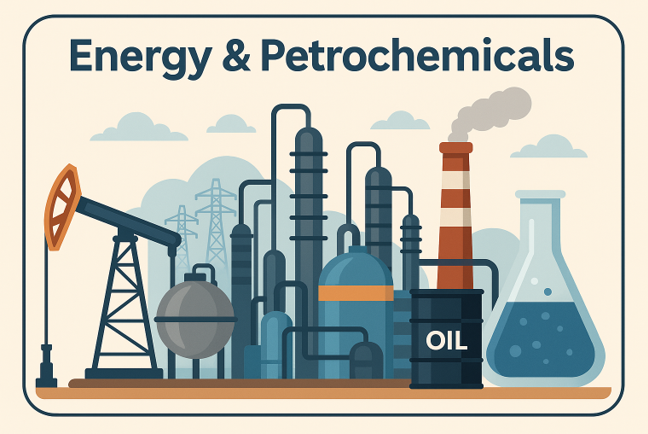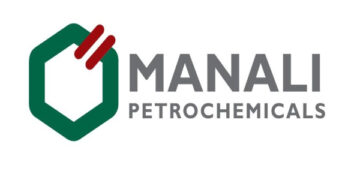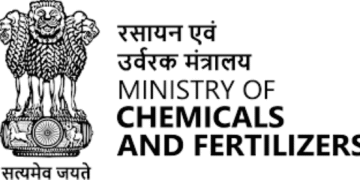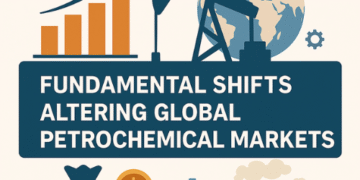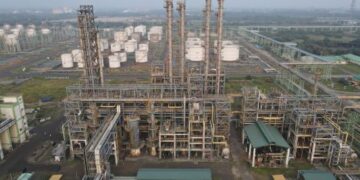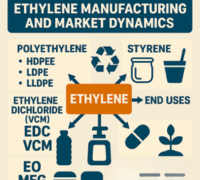Introduction
One of the poignant examples of modern industrial alliances is the relationship between the energy and petrochemical sectors. Energy is both a necessary input and a production driver for petrochemicals. At the same time, the energy industry increasingly relies on petrochemicals as a new growth pillar after scandals shifted the focus of the energy economy. This synergy drives both economic growth and the production of globally essential materials. However, the energy and petrochemical industries are poised to undergo substantial changes due to new market conditions, technological innovations, and climate commitments.
This blog focuses on the fundamentals of the industry, as well as the market landscape, key drivers and challenges, innovations, and survival strategies planned for an increasingly volatile global landscape.
Understanding the Petrochemical Industry
Petrochemicals are produced mainly from crude oil, natural gas, and, in rare cases, coal. They act as precursors to myriad products such as plastics, synthetic and natural fibers, rubber, detergents, a variety of solvents, fertilizers, and coatings. Petrochemicals are vital to key sectors such as healthcare, automotive, construction, electronics, and consumables.
An industry structure can usually be classified as follows:
- Upstream: Includes the search for and production of oil and gas.
- The midstream category incorporates the transportation, storage, and wholesale marketing of hydrocarbons. The downstream sector, as coined, encompasses the refining of crude oil and gas, and additionally includes the production of petrochemicals and other derivatives.
- The downstream petrochemical segment takes raw materials, or feedstocks, such as ethylene, propylene, benzene, and methanol, and transforms them into other products or intermediate materials. In the absence of these petrochemical derivatives, contemporary manufacturing would struggle to operate and scale.
Market Size and Growth Outlook
The global demand for petrochemicals has steadily increased over the years due to the population and urbanization growth as well as as increase in industrial activities. Increased demand for petrochemicals, and the resilience of the industry, stems from the integration of the petrochemical industry into other critical value chains, which insulates them from certain economic downturns.
As forecasted, and in line with other commodities, the petrochemical market value
was in the mid hundreds of billions of dollars in 2023 and is projected to sustain growth for at least another 10 years. In the Asia Pacific region, China and India are the leaders in consumption as they are enduring rapid industrialization with higher consumer demand.
Moreover, the Middle East continues to be a crucial production hub due to their abundant hydrocarbon reserves as well as their comparatively low production costs.
Furthermore, the wider market for energy-related chemicals — including petrochemicals and other industrial synthetic chemicals — is also progressing in a well-organized manner. This is aided by the global energy transition, which is seeking new materials for the infrastructure needed to support renewable energy, electric vehicles, and energy storage systems.
The Current Situation In The Industry
A significant transformation is taking place in the petrochemical industry. Many oil and gas companies are increasingly seeking to boost their production of petrochemicals because the demand for transport fuels is plateauing and energy efficiency policies are curbing the growth in gasoline and diesel fuel consumption. This is aimed at alleviating the decline in revenues from conventional energy sources.
There are, however, undergoing challenges due to the pivot. The demand for petrochemicals is particularly low in the Middle East and Asia who have rapidly growing production capabilities. This is squeezing profit margins and fueling competition. Some producers are considering rational capacity reduction, formation of strategic partnerships, or diversifying into specialty chemicals to maintain profitability.
The respective market has been made more challenging due to the interrelation of geopolitical occurrences, the movement of global supply chains, and a dynamically shifting pricing model of feedstock. The volatility of global oil and gas prices aggravates the expense of producing petrochemicals in regions that lean significantly on imported feedstocks.
The Core Drivers of Expansion
A significant transformation is taking place in the petrochemical industry. Many oil and gas companies are increasingly seeking to boost their production of petrochemicals because the demand for transport fuels is plateauing and energy efficiency policies are curbing the growth in gasoline and diesel fuel consumption. This is aimed at alleviating the decline in revenues from conventional energy sources.
There are, however, undergoing challenges due to the pivot. The demand for petrochemicals is particularly low in the Middle East and Asia who have rapidly growing production capabilities. This is squeezing profit margins and fueling competition. Some producers are considering rational capacity reduction, formation of strategic partnerships, or diversifying into specialty chemicals to maintain profitability.
The respective market has been made more challenging due to the interrelation of geopolitical occurrences, the movement of global supply chains, and a dynamically shifting pricing model of feedstock. The volatility of global oil and gas prices aggravates the expense of producing petrochemicals in regions that lean significantly on imported feedstocks.
The Core Drivers of Expansion
a) An Indispensable Part of Day-to-Day Living
Petrochemicals are relied on by almost all sectors of the economy. The demand for petrochemicals is fueled by the lightweight automotive parts and components in renewable energy systems, as well as food packaging and medical devices.
b) Urban Sprawl and Developing Economies
In the developing world, the demand for housing and consumer goods is increasingly driven by rising mid-class populations. These consumer goods and the associated infrastructure and logistics are heavily dependent on petrochemical materials.
c) Opportunities from the Transition in Energy
The demand for renewable energy paradoxically increases the demand for petrochemicals. Electric vehicles, as well as wind turbines and solar panels, use petrochemicals in the polymers and composites used to manufacture them.
d) Advancements In Technology
The improvements in yield and efficiency that have been caused by innovations in chemicals and the processing industry have made it possible for producers to function in challenging price conditions.
The Issues Facing This Industry
a) Margin Pressure and Oversupply
The rapid expansion in several low-priced feedstock regions created a unique imbalance in supply and demand. This imbalance also lowered the price of key petrochemicals like ethylene and polyethylene.
b) Environmental and Other Regulatory Pressures
More than ever, industry observers are paying close attention to the environmental consequences of petrochemical industries. Many countries, by now, are already paying attention to the greenhouse gases emitted, the energy utilized, and the waste emitted in the form of plastic products by the sector.
c) Volatility of Feedstock
The production and profitability of a business are impacted by the prices of crude oil and natural gas. Manufacturers relying on imported feedstock face additional challenges in the form of currency exchange rates and interruptions in trade.
d) Competition from Other Oalternate Materials
The worries of sustainability have brought about the manufacture of bio-based, and recyclable materials, which in the future, can replace petrochemical products.
Digital Transformation, Sustainability, and Innovation
The industry’s continuous evolution hinges on the successful implementation of innovations and the industry’s commitment to sustainability.
a) Transformation in the Digital World
The operation, downsizing, and even the safety of the company can now be improved by the use of AI, IoT, and even predictive analytics. Digital plants are capable of predicting the demand and better managing the inventory and, hence, control the entire supply chain.
b) Models of the Circular Economy
There is a change in strategic focus towards the recycling and chemical flower recycling of plastic. Advanced chemical recycling technologies change plastic waste to feedstock, thus, reducing the reliance on virgin hydrocarbons.
c) Alternative Feedstocks
The bio-based feedstock and CO₂ utilization technologies research is being done in order to lessen the greenhouse gas emissions from petrochemical operations.
d) Energy Efficiency and Electrification
The use of processes powered by renewable resources and the improvement of energy efficiency at the plants is proving to be beneficial from a market competition perspective.
For the latest innovations in the sector and changes to policies, professionals can visit the ChemDive webpage and explore the energy and petrochemical insights section.
Strategic Pathways For Stakeholders
a) Portfolio Diversification
Focusing the business on specialty chemicals and advanced materials rather than commodity petrochemicals is likely to improve margins and reduce exposure to cycles of oversupply.
b) Vertical Integration
Owning the feedstock sources and the downstream manufacturing processes enables greater market access and better pricing on the petrochemicals.
c) Strategic Partnerships and M&A
Growth opportunities can be реализованы from joint ventures with technology partners in emerging markets or from targeted mergers and acquisitions.
d) Investments For Decarbonization
The updated reputation and better access to financing comes from investing in low-carbon technologies, integrating renewables to meet regulatory demands, and decarbonization.
Conclusion
Simultaneously, both the energy and petrochemical sectors are undergoing critical transformations. Business practices within the sectors are being challenged to adapt to contemporaneous societal demands and environmental scrutiny. However, the sectors are experiencing a once-in-a-lifetime opportunity for change. Companies that are able to embrace and implement sustainability will reap the rewards in the decades to come.
Petrochemicals are the backbone of modern society as they provide the raw materials for renewable energy, construction, and maintenance of infrastructure, and sustain and elevate the global standard of living. The challenge, or paradox, is to optimize the approaches towards the production of petrochemicals to meet the requirements of a more agile, evolving world.References:
https://www.marketresearchfuture.com/reports/energy-chemical-market-25136
https://chemdive.com/category/petrochemicals/

